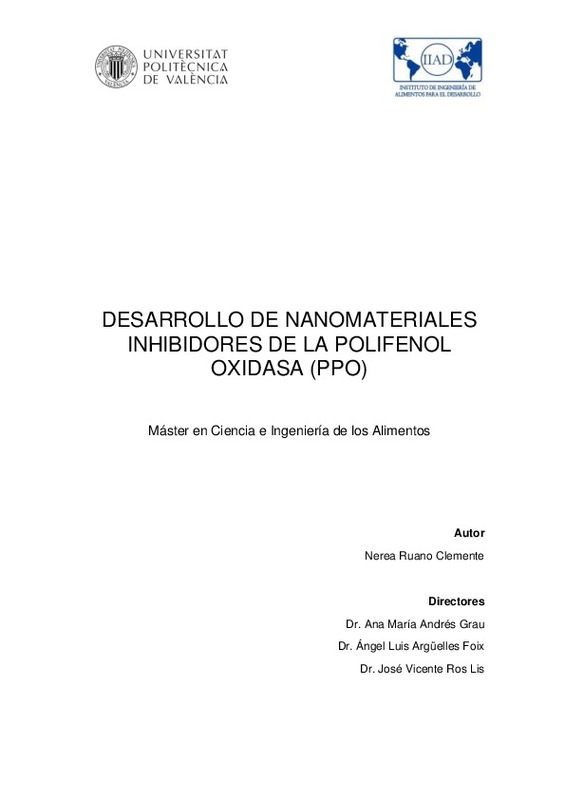|
Resumen:
|
[ES] La polifenol oxidasa (PPO) es una enzima que causa la reacción que se
conoce como pardeamiento enzimático en muchas de las frutas y verduras
que consumimos y que se traduce en un detrimento en su color, sabor, olor ...[+]
[ES] La polifenol oxidasa (PPO) es una enzima que causa la reacción que se
conoce como pardeamiento enzimático en muchas de las frutas y verduras
que consumimos y que se traduce en un detrimento en su color, sabor, olor y
valor nutricional. La actuación de la enzima se basa en la oxidación de los
compuestos fenólicos presentes en frutas y verduras para generar
pigmentos parduzcos. Los nanomateriales mesoporosos, que han tenido una
gran variedad de aplicaciones en los últimos años, podrían tener una
funcionalidad potencial para la inmovilización de enzimas en procesos de la
industria alimentaria, lo que permitiría desarrollar un método alternativo a los
tratamientos térmicos tradicionales utilizados en la industria alimentaria. El
objetivo de este trabajo es estudiar el potencial de retención de la PPO y de
inhibición de su actividad utilizando diferentes materiales mesoporosos con
diferentes estructuras, morfología y porosidades, y poder evaluar su
capacidad de inmovilización e inhibición en disoluciones modelo preparadas
con un enzima comercial. Los ensayos fueron realizados con los materiales
Aerosil, MCM-41 Micro, MCM-41 Nano y UVM-7 y posteriormente con estos
mismos materiales funcionalizados con grupos tioles. Todos los ensayos
fueron realizados a un pH de 3,5 ya que este valor es el más común entre
frutas y verduras. El nanomaterial que mejor respuesta obtuvo en cuanto a la
inhibición de la PPO fue el UVM-7 funcionalizado con tioles.
[-]
[EN] Polyphenol oxidase (PPO) is an enzyme that causes the reaction is known
as enzymatic browning in many of the fruits and vegetables we eat and which
results in a detriment in color, taste, smell and nutritional value. ...[+]
[EN] Polyphenol oxidase (PPO) is an enzyme that causes the reaction is known
as enzymatic browning in many of the fruits and vegetables we eat and which
results in a detriment in color, taste, smell and nutritional value. The action of
the enzyme is based on the oxidation of phenolic compounds present in fruits
and vegetables to generate brownish pigments. Mesoporous nanomaterials
which have had many applications in recent years, may have potential
functionality for the immobilization of enzymes in processes of the food
industry, allowing to develop an alternative method to traditional thermal
treatments used in industry food. The objective of this work is to study the
potential retention and inhibition of PPO activity using different mesoporous
materials with different structures, morphology and porosity, and to evaluate
their immobilization capacity and inhibition in model solutions prepared with a
commercial enzyme. The assays were conducted with the Aerosil, MCM-41
Micro, MCM-41 Nano and UVM-7 materials and subsequently with these
same materials functionalized with thiol groups. All assays were performed at
pH 3.5, that value is the most common fruits and vegetables. The
nanomaterial best response obtained for inhibition of PPO was thiol
containing UVM-7.
[-]
|







